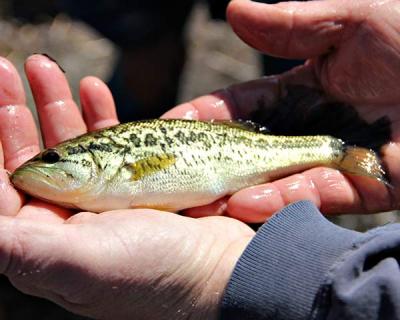Nature Notes: A Montauk Pond Tour

The weekend was a blaze of glory. The sun shone, the bay waters were mostly calm, the shads and sweet cherries began to bloom to the west, and the shads along Napeague and in Montauk were on the verge of busting out. Soon the oaks, hickories and sassafras will flower and leave. The red maples and Norway maples have been flowering for more than a week now. They’ll soon sprout leaves; they always lead the pack where foliation is concerned.
I spent a wonderful Sunday with Montauk’s Third House Nature Club and its three East Hampton High School senior interns. I brought along Howard Reisman, a master ichthyologist and retired Long Island University professor, to help test the waters of Big Reed Pond. Like Georgica Pond and Mill Pond, it has been having a problem lately with blue-green algae. There had been a big fish kill in 2011, and the pond has yet to recover.
The East Hampton Town Natural Resources Department loaned us a 50-foot beach seine. Howard taught the group how to use it and we were able to make a couple of seines despite the large masses of gelatinous blue-green algae clogging the mesh. We caught (and returned unharmed) freshwater killifish, Fundulus diaphanous, and one teenage white perch, Morone Americana. Both species are common in Fort Pond a few miles to the west of Big Reed. Fort Pond is the second largest pond on Long Island after Lake Ronkonkoma.
Our seining was promising because, while we didn’t catch any eels, largemouth bass, or pumpkinseeds, some of the killies were in the early stage of development, which indicated that their reproduction is carrying. It is too early to say if the fish are making a comeback, but there were spots along the eastern and southern parts of the pond where you could see clear to the bottom in five feet of water. That may be because the noxious blue-green algae have just started to reproduce, as the water temperature until recently has been quite cold as a result of the harsh winter during which the pond was frozen solid for almost three months.
Big Reed Pond is one of those water bodies that was formed by sand washing westerly along the north side of Montauk Point, trapping behind it water lying between the north slope of the geologic till and Block Island Sound. Oyster Pond, a little to the east of Big Reed, has a similar origin, but it is yet to be completely landlocked. It has an intermittent opening to the sea and is brackish for part of the year, thus supporting a healthy oyster stock. Big Reed has a dug channel that empties into Little Reed Pond to the east, which in turn is connected by a tidal stream to Lake Montauk.
The Third House Nature Club is working to clear the channel and replace a culvert under the road to the pond so that water can flow more fully and fish such as eels, alewives, and white perch can move between Big Reed and Lake Montauk, which is open to Block Island Sound year round.
One has to remember that until a few hundred years or so ago the beach along the north side of Montauk between the Lighthouse and the Lake Montauk inlet was building seaward by virtue of the re-entrant sand. In the last 10 years at least, the beach — with the exception of Gin Beach, protected by the sand-blocking jetty on the east side of Lake Montauk — has been cutting back at more than five feet per year. With rising sea level and cyclical northeasters and tropical storms afoot both Big Fresh and Oyster Ponds are fated to become part of Block Island Sound.
On Sunday egrets and great blue herons were flying, landing, and fishing. Several cormorants flew around and a couple splashed in. An osprey flew back and forth over the nesting platform that the club recently erected on the pond’s north shore, but did not land. Ospreys haven’t nested in Montauk for several years now after abandoning a nest up on the hill east of Lake Montauk.
Painted turtles splashed into the water from their sunning perches on glacial erratics as we approached. Those who know the pond well have seen large snapping turtles in it as well from time to time.
On the way back to Sag Harbor, Howard and I checked out the four ponds that were created around Lake Montauk to trap sediment and reduce nitrates prior to runoff water flowing over weirs and making its way into the lake by way of culverts under West Lake Drive, East Lake Drive, and Montauk Highway. The fifth pond, which was to be on a piece of town land occupied by a private resident’s driveway off East Lake Drive near the trail to Big Fresh Pond, was never installed. The other four are doing well, but they are collectively looking forward to the time when they will be joined by a fifth.
Larry Penny can be reached via email at [email protected].
